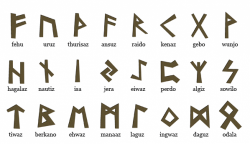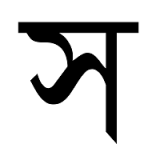Alphabets Page #18
This page lists all the various symbols in the Alphabets category.

An alphabet is a standard set of letters (basic written symbols or graphemes) that is used to write one or more languages based on the general principle that the letters represent phonemes (basic significant sounds) of the spoken language. This is in contrast to other types of writing systems, such as syllabaries (in which each character represents a syllable) and logographies (in which each character represents a word, morpheme, or semantic unit).
Symbols in this category:
rēš
Resh is the twentieth letter of the Semitic abjads, including Phoenician Rēsh Phoenician res.svg, Hebrew Rēsh ר, Aramaic Rēsh Resh.svg, Syriac Rēsh ܪ, and Arabic Rāʾ ر. Its sound value is one of a number of rhotic consonants: usually [r] or [ɾ], but also [ʁ] or [ʀ] in Hebrew.
Rēsh
Resh is the twentieth letter of the Semitic abjads, including Phoenician Rēsh Phoenician res.svg, Hebrew Rēsh ר, Aramaic Rēsh Resh.svg, Syriac Rēsh ܪ, and Arabic Rāʾ ر. Its sound value is one of a number of rhotic consonants: usually [r] or [ɾ], but also [ʁ] or [ʀ] in Hebrew.
Resh Letter
Resh is the twentieth letter of the Semitic abjads, including Phoenician Rūsh , Hebrew Rēsh ר, Aramaic Rēsh , Syriac Rēsh ܪ, and Arabic Rāʾ ر. Its sound value is one of a number of rhotic consonants: usually [r] or [ɾ], but also [ʁ] or [ʀ] in Hebrew and North Mesopotamian Arabic.
Rho
Rho is the 17th letter of the Greek alphabet. In the system of Greek numerals, it has a value of 100. It is derived from Phoenician letter res Phoenician res.svg. Its uppercase form is not to be confused with the Latin letter P, although both types use the same glyph: P.
Sa (kana)
さ, in hiragana, or サ in katakana, is one of the Japanese kana, which each represent one mora. Both represent [sa]. The shapes of these kana originate from 左 and 散, respectively.
ṣādē
Ṣade (also spelled Ṣādē, Tsade, Ṣaddi, Ṣad, Tzadi, Sadhe, Tzaddik) is the eighteenth letter of the Semitic abjads, including Phoenician Çādē Phoenician sade.svg, Hebrew Ṣādi צ, Aramaic Ṣāḏē Sade 1.svg, Syriac Ṣāḏē ܨ, and Arabic Ṣād ص. Its oldest sound value is probably /sˤ/, although there is a variety of pronunciation in different modern Semitic languages and their dialects. It represents the coalescence of three Proto-Semitic "emphatic consonants" in Canaanite. Arabic, which kept the phonemes separate, introduced variants of ṣād and ṭāʾ to express the three (see ḍād, ẓāʾ). In Aramaic, these emphatic consonants coalesced instead with ʿayin and ṭēt, respectively, thus Hebrew ereṣ ארץ (earth) is araʿ ארע in Aramaic.
Ṣādhē
Ṣade (also spelled Ṣādē, Tsade, Ṣaddi, Ṣad, Tzadi, Sadhe, Tzaddik) is the eighteenth letter of the Semitic abjads, including Phoenician Çādē Phoenician sade.svg, Hebrew Ṣādi צ, Aramaic Ṣāḏē Sade 1.svg, Syriac Ṣāḏē ܨ, and Arabic Ṣād ص. Its oldest sound value is probably /sˤ/, although there is a variety of pronunciation in different modern Semitic languages and their dialects. It represents the coalescence of three Proto-Semitic "emphatic consonants" in Canaanite. Arabic, which kept the phonemes separate, introduced variants of ṣād and ṭāʾ to express the three (see ḍād, ẓāʾ). In Aramaic, these emphatic consonants coalesced instead with ʿayin and ṭēt, respectively, thus Hebrew ereṣ ארץ (earth) is araʿ ארע in Aramaic.
Citation
Use the citation below to add this symbols category to your bibliography:
Style:MLAChicagoAPA
"Alphabets Symbols." Symbols.com. STANDS4 LLC, 2024. Web. 21 Dec. 2024. <https://www.symbols.com/category/66/Alphabets>.

















Have a discussion about the Alphabets category with the community:
Report Comment
We're doing our best to make sure our content is useful, accurate and safe.
If by any chance you spot an inappropriate comment while navigating through our website please use this form to let us know, and we'll take care of it shortly.
Attachment
You need to be logged in to favorite.
Log In